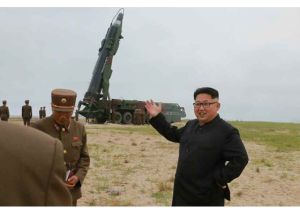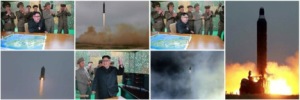A Partial Success for the Musudan
Summary
North Korea’s latest Musudan (Hwasong-10) missile test finally demonstrated the full performance of the missile’s propulsion system, and at least a minimally functional guidance system. The trajectory was not representative of an operational launch, and so leaves open questions about the performance of the reentry vehicle. Perhaps more importantly, two launches only a few hours apart and with one missile breaking up in flight, gives the North Koreans little chance of understanding what went wrong. The Musudan is not a reliable weapon, and Pyongyang does not seem to be trying to make it a reliable weapon. But even if this is just a propaganda stunt and the Musudan is to be quietly abandoned, this partial success increases the likelihood that North Korea’s KN-08 and KN-14 road-mobile inter-continental ballistic missiles (ICBMs) will reach operational status early in the next decade.

The Persistent Pursuit of the Musudan
After four consecutive failures in rapid succession, we figured we might have seen the last of North Korea’s Musudan missile. Given the pace of testing earlier this year, faster than any technical results could be interpreted and incorporated into a revised design, there was little chance of North Korea obtaining a useful weapon. At best, and only by luck, it might have scored a propaganda victory with a marginally successful flight. And with every failure, the odds of that seemed increasingly remote.
But if the North Koreans are in too much of a hurry to do the job right, they are at least persistent in doing something. And now it appears that they have at least a partial success to show for it. We have confirmed reports that two missiles were fired from mobile launchers near Wonsan on June 21, with one missile disintegrating in flight perhaps 150 km downrange and the second impacting at a range of 400 km. That is little more than a tenth of the Musudan’s expected range of roughly 3,500 km, but it is more than we had ever seen before.
This may be due to a modification in the missile’s aerodynamics. North Korea has released pictures of what appears to be a Musudan in flight with a set of eight grid fins around the base, which weren’t present in previous satellite or parade photos or in the old Soviet R-27 missile on which the Musudan is based. Presumably the North Korean engineers guessed that their modifications to the Musudan had compromised its stability in early flight, and that some extra aerodynamic controls would fix that problem. With no more than two months to work, this cannot have been much more than a jury-rigged fix based on an educated guess, but it was apparently a good one. Now they have to guess what went wrong to cause a missile to break up at 150 km, which will be rather more difficult.

Reports from Japan indicate that the second missile had reached an altitude of over 1,000 km, with North Korea claiming a very precise 1,413.6 km. This is far higher than would be normal for a missile of that size. A bit of analysis indicates that achieving this altitude would require roughly the full performance of the Musudan missile’s propulsion system, devoted to an almost perfectly vertical ascent. That’s not very useful from a military perspective, but it is still an impressive feat for a missile that last month was blowing up on the launch pad.
As a test, this isn’t as useful as launching the missile on its more usual ballistic arc. It gives the engines a full workout, but makes it harder to verify the performance of the guidance system. It also provides a different reentry environment, and testing the reentry vehicle is going to be critical to North Korea. Their older missiles entered the atmosphere at no more than half the Musudan’s speed. The North Koreans probably now know, for the first time, what happens when one of their warheads enters the atmosphere at roughly 10,000 miles per hour, but at an abnormally steep angle which will give a shorter but more intense heating load and do most of its deceleration lower in the atmosphere than it would in an operational launch. They might still not know whether the warhead would survive in an operational flight.
Why would they have tested a missile in such a manner? Examining a map of the region shows that there is really no way to launch a missile from Wonsan to a range of more than 1,000 km without overflying some foreign country, most likely Japan. The Japanese take a dim view of North Korean missiles flying over their country, and they have Aegis-equipped warships capable of shooting down missiles. Pyongyang apparently didn’t want to take that provocative risk.
They could have launched the missile from their Sohae Satellite Launching Station, which has clear range to the south as far as the Philippines. North Korea’s orbital launches have used this site and this trajectory, and it would have made for a more realistic test of the Musudan. Given that the Musudan is a mobile missile, they could have launched from any paved road along the southeast coast for the same effect. But North Korea’s engineers almost certainly would have wanted the support of powerful tracking radars and other infrastructure associated with a permanent launch site, and the Sohae site has only been used for North Korea’s nominally civilian satellite launches. There may have been some internal politics involved in the decision to loft the missile high over the East Sea and bring it down at such a short range.
The bigger limitation of this test is the decision to launch two missiles only a few hours apart. That decision greatly limits what can actually be learned from the test. There is no possibility, in that timeframe, of figuring out what went wrong with the first missile and fixing it. As with the earlier Musudan tests, this isn’t so much an engineering program so much as an exercise in tossing a coin or rolling a die until it comes up with the result they like. If North Korea’s sixth and latest Musudan launch counts as a success in their minds—and it well might—the one before it was still clearly a failure. Do they now have a reliable missile that had a spot of bad luck, or a dud that got lucky and worked once? We don’t know. Neither do they. And they knew from the start that they wouldn’t know if they had a reliable missile in the end.
So we should probably assume they don’t really care, that this was about propaganda and image rather than engineering and weapons development. They have achieved something that is as close to a win as possible without overflying Japan, and if they try again there’s a good chance that Musudan #7 will be an embarrassing failure just like Musudan #5.
Best case, they declare victory and go home, and make a quiet note to never actually trust the Musudan in wartime. Worst case, they tell their engineers to go back to their ground test facilities and turn this one-shot stunt into a useful weapon. The engineers in question would probably be quite happy to know they still have jobs, and turning the results from this spurt of unreasonably fast testing into a reliable weapon, would occupy them for a year or two at least. If they come back a year from now, testing Musudan missiles one at a time and with three to six months between tests, then we can start worrying about an operational Musudan.
But we should also consider worrying about an operational KN-08 or KN-14. These missiles use the same ex-Soviet engine as the Musudan, but in a clustered and multi-stage configuration capable of reaching much of the US mainland. We have seen them test this engine on the ground, but until now they had never successfully flown one. Even if North Korea retires the Musudan as too unreliable for anything but propaganda stunts, they will presumably ship any test data to the engineers building the ICBMs. And those engineers don’t seem to be under any pressure to rush into premature flight testing.
Regardless of the ultimate fate of the Musudan, the credibility of the KN-08 and KN-14 road-mobile ICBMs has increased a few notches. The North Koreans have the engines they need, and they can at least sometimes make them work in flight. There is still a great deal of work for them to do. The clustered twin-engine installation in particular will likely give them a few surprises on its first flight, and it will likely take them several tries to get the complete system right. We still don’t expect them to have those missiles operational before 2020, but early flight testing by that date is increasingly likely.
_____
Addendum: Since the publication of this analysis, North Korea released an image of Kim Jong Un in front of a Musudan missile with the reentry vehicle removed. The author offers additional observations here.
